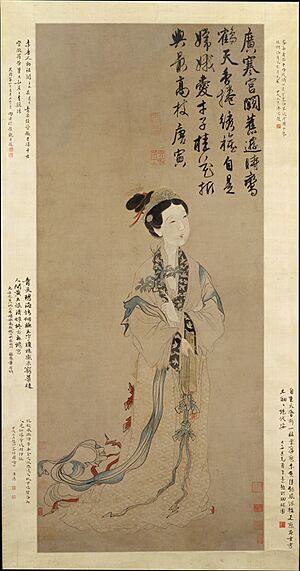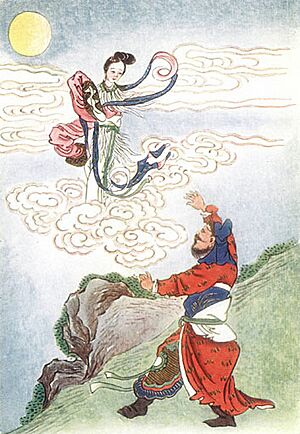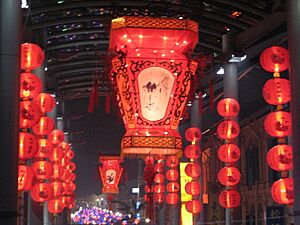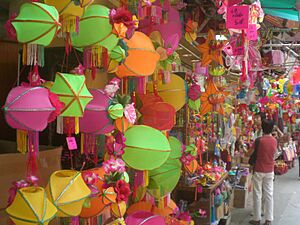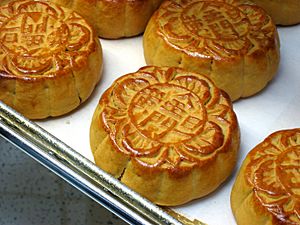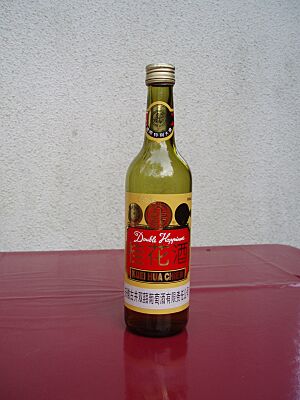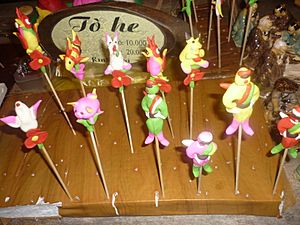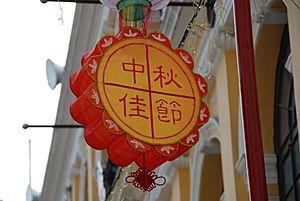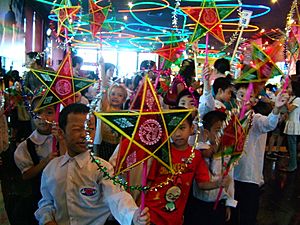Mid-Autumn Festival facts for kids
Quick facts for kids Mid Autumn Festival |
|||||||||||||||||||||||||||||||||||
|---|---|---|---|---|---|---|---|---|---|---|---|---|---|---|---|---|---|---|---|---|---|---|---|---|---|---|---|---|---|---|---|---|---|---|---|
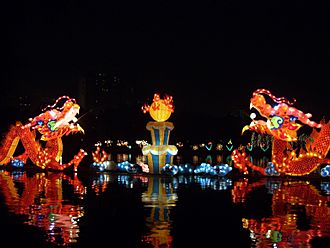
Festival decorations in Beijing
|
|||||||||||||||||||||||||||||||||||
| Also called | Moon Festival, Mooncake Festival | ||||||||||||||||||||||||||||||||||
| Observed by | Chinese people | ||||||||||||||||||||||||||||||||||
| Type | Cultural, religious | ||||||||||||||||||||||||||||||||||
| Significance | To commemorate and celebrate the end of the autumn harvest | ||||||||||||||||||||||||||||||||||
| Celebrations | Lantern lighting, mooncake making and sharing, courtship and matchmaking, fireworks, family gathering, dragon dances, family meal, visiting friends and relatives, gift giving | ||||||||||||||||||||||||||||||||||
| Observances | Consumption of mooncakes and cassia wine | ||||||||||||||||||||||||||||||||||
| Date | 15th day of the 8th month of the Chinese lunar calendar | ||||||||||||||||||||||||||||||||||
| 2024 date | 17 September | ||||||||||||||||||||||||||||||||||
| 2025 date | 6 October | ||||||||||||||||||||||||||||||||||
| 2026 date | 25 September | ||||||||||||||||||||||||||||||||||
| Frequency | Annual | ||||||||||||||||||||||||||||||||||
| Related to | Chuseok (Korea), Tsukimi (Japan), Tết Trung Thu (Vietnam), Uposatha of Ashvini or Krittika (Cambodia, Laos, Myanmar, Sri Lanka, and Thailand) | ||||||||||||||||||||||||||||||||||
| Chinese name | |||||||||||||||||||||||||||||||||||
| Traditional Chinese | 中秋節 | ||||||||||||||||||||||||||||||||||
| Simplified Chinese | 中秋节 | ||||||||||||||||||||||||||||||||||
| Literal meaning | "Mid-Autumn Festival" | ||||||||||||||||||||||||||||||||||
|
|||||||||||||||||||||||||||||||||||
| Calendar date name | |||||||||||||||||||||||||||||||||||
| Chinese | 八月十五/八月半 | ||||||||||||||||||||||||||||||||||
| Literal meaning | "Fifteenth/Half of the Eighth Month" | ||||||||||||||||||||||||||||||||||
|
|||||||||||||||||||||||||||||||||||
| Regional name | |||||||||||||||||||||||||||||||||||
| Traditional Chinese | 八月節 | ||||||||||||||||||||||||||||||||||
| Literal meaning | "Eighth Month Festival" | ||||||||||||||||||||||||||||||||||
|
|||||||||||||||||||||||||||||||||||
The Mid-Autumn Festival is a special harvest festival celebrated in Chinese culture. It happens on the 15th day of the 8th month of the Chinese lunar calendar. This is when the full moon shines brightest at night. It usually falls between mid-September and early October in the Gregorian calendar. People in China believe the moon is at its fullest and brightest during this time, which matches the autumn harvest season.
This festival is one of the most important holidays in Chinese culture. It is almost as popular as Chinese New Year. The festival's history goes back more than 3,000 years. Other countries in East and Southeast Asia celebrate similar festivals.
During the festival, people carry and display lanterns of all shapes and sizes. These lanterns symbolize good luck and a bright future. A traditional sweet pastry called mooncakes is also eaten. Mooncakes are usually filled with sweet-bean or lotus-seed paste. The Mid-Autumn Festival is based on the old story of Chang'e, who is the Moon goddess in Chinese mythology.
Contents
What is the Mid-Autumn Festival?
The festival is called "Mid-Autumn" because it takes place around the autumn equinox. This is on the 15th day of the 8th month in the Chinese calendar. Its name changes depending on the Chinese language spoken. The most common name is Mid-Autumn Festival or simply Mid-Autumn.
Other names include:
- Fifteenth of the Eighth Month or Half of the Eighth Month.
- Eighth Month Festival in places like Northeast China.
- Festival of Unity in Shanghai and Nanjing.
- Mooncake Festival in Guangdong and Hong Kong.
Outside China, the festival has other names:
- Chuseok in Korea. This festival is celebrated on the same day.
- Tsukimi in Japan, which means "moon viewing."
- Tết Trung Thu in Vietnam, also known as The Children's Festival. Children often sing festival songs.
- Lantern Festival, sometimes used in Singapore, Malaysia, and Indonesia. This is different from the Lantern Festival in China, which happens in the first month of the Chinese calendar.
- Bon Om Touk, or The Water and Moon Festival in Cambodia. This festival is held for three days in November.
Why is the Mid-Autumn Festival important?
The festival celebrates three main ideas:
- Gathering: Families and friends come together. It is also a time for harvesting crops. The moon is brightest and roundest on this day, which represents family reunion. This is a key reason why the festival is so important.
- Giving Thanks: People give thanks for the harvest. They also thank each other for good relationships, often by sharing mooncakes.
- Praying: People pray for things like having children, finding a partner, beauty, long life, or a good future.
The traditions and stories around the festival are built on these ideas. Over time, traditions have changed due to new technology, science, economy, culture, and religion.
History of the Festival
Chinese people have celebrated the harvest during the autumn full moon since the Shang dynasty (around 1600–1046 BCE). The name mid-autumn first appeared in Rites of Zhou. This was a collection of rituals from the Western Zhou dynasty (1046–771 BCE). The royal court dedicated this day to the goddess Taiyinxingjun. This tradition is still part of Taoism and Chinese folk religion.
The celebration became a popular festival during the early Tang dynasty (618–907 CE). One story says that Emperor Xuanzong of Tang started formal celebrations in his palace. He did this after visiting the Moon-Palace in a dream.
By the Ming and Qing Dynasties, the Mid-Autumn Festival was one of China's main folk festivals. Empress Dowager Cixi (in the late 1800s) loved celebrating it so much. She would spend several days staging special rituals.
Moon Worship and Legends
Worshipping the Moon is a very important part of the festival. Ancient Chinese people believed the Moon and water were linked to new life. This made it popular for women to worship the Moon and offer gifts on this evening. In some parts of China, there is a saying that "men do not worship the moon and women do not offer sacrifices to the kitchen gods."
In China, the Mid-Autumn Festival represents family reunion. Families gather in the evening to admire the Moon. This is because on the 15th day of the 8th lunar month, the moon is at its fullest.
People also make offerings to Chang'e, the Moon Goddess of Immortality. The stories about Chang'e explain why people worship the Moon on this day. One popular story tells of a hero named Hou Yi who was a great archer. His wife was Chang'e. One year, ten suns appeared in the sky, causing great trouble. Yi shot down nine of them, leaving only one. An immortal gave Yi a special potion for eternal life. Yi did not want to be immortal without Chang'e, so he let her keep the potion.
However, one of his students, Peng Meng, found out. On the 15th of August in the lunar calendar, when Yi was hunting, Peng Meng broke into their home. He tried to force Chang'e to give him the potion. Chang'e refused and instead swallowed it herself. She then floated up to the sky. Because she loved her husband and wanted to stay close, she chose the Moon as her home. When Yi returned and learned what happened, he was very sad. He put out fruits and cakes that Chang'e liked in the yard as offerings. People soon heard the story and joined Yi in making sacrifices to Chang'e. This custom of praying to the Moon on Mid-Autumn Day has continued for thousands of years.
Another common version of the story says that after Houyi shot down the suns, he became a king. But he soon became mean and unfair. To live forever, he asked for the potion from Xiwangmu. His wife, Chang'e, stole it on the 15th of August. She did not want the cruel king to live long and harm more people. She took the magic potion to stop him from becoming immortal. Houyi was very angry when he found out. He shot at his wife as she flew to the moon, but he missed. Chang'e escaped to the moon and became the spirit of the moon. Houyi soon died from his anger. After that, people offer sacrifices to Chang'e every 15th day of the 8th month to remember her brave act.
How the Festival is Celebrated
The festival was a time to enjoy the successful harvest of rice and wheat. People made food offerings to honor the moon. Today, it is still a time for friends and family to gather outdoors. They eat mooncakes and watch the Moon, which symbolizes peace and togetherness. If there is a solar eclipse during the year, government offices, banks, and schools might close for extra days. This allows people to enjoy the special sky event. The festival has many cultural and regional customs, including:
- Burning incense to show respect to gods and goddesses like Chang'e.
- Performing dragon and lion dances, especially in southern China.
Lanterns
A big part of the holiday is carrying bright lanterns. People also light lanterns on tall towers or float sky lanterns. Another tradition is to write riddles on lanterns and have others try to guess the answers. These are called "lantern riddles."
It is not clear when lanterns first became part of the festival. But they were not used with Moon-worship before the Tang dynasty. Traditionally, lanterns symbolized new life and were mainly toys and decorations. Today, the lantern has become a symbol of the festival itself. In the past, lanterns looked like natural things, myths, and local culture. Over time, more types of lanterns appeared as different cultures influenced each other.
As China changed from a farming society to one with both farming and trade, traditions from other festivals joined the Mid-Autumn Festival. For example, putting lanterns on rivers to guide the spirits of drowned people. This was done during the Ghost Festival, which happens a month before. Fishermen in Hong Kong during the Qing dynasty would put lanterns on their boats for the Ghost Festival and keep them until the Mid-Autumn Festival.
Mooncakes
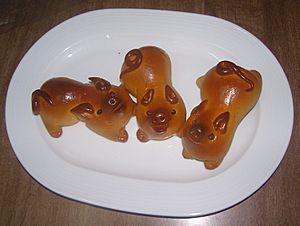
Making and sharing mooncakes is a key tradition of this festival. In Chinese culture, a round shape means completeness and coming together. So, sharing and eating round mooncakes among family members during the festival week shows family unity. In some parts of China, families make mooncakes on the night of the festival. The oldest person in the house cuts the mooncakes and gives a piece to each family member. This symbolizes family reunion. Today, people usually buy mooncakes to give as gifts, but the meaning of family unity remains.
Most mooncakes are a few centimeters wide. But imperial chefs once made some as large as 8 meters across! These huge mooncakes had designs of Chang'e, cassia trees, or the Moon-Palace. One tradition is to stack 13 mooncakes to look like a pagoda. The number 13 represents the 13 months in a full Chinese lunar year. Making very large mooncakes is still a spectacle in modern China.
According to Chinese stories, a businessman from Turpan offered cakes to Emperor Taizong of Tang. This was after his victory against the Xiongnu on the 15th day of the 8th lunar month. Taizong took the round cakes and pointed to the moon, saying, "I'd like to invite the toad to enjoy the hú cake." After he shared the cakes with his officials, eating these hú cakes became popular across the country. Eventually, they became known as mooncakes. While this story explains the start of mooncake giving, their popularity with the festival grew during the Song dynasty (906–1279 CE).
Another popular story is about the Han Chinese uprising against the Mongols at the end of the Yuan dynasty (1280–1368 CE). The Han Chinese used traditional mooncakes to hide a secret message. The message told them to rebel on Mid-Autumn Day. The Mongols had strict rules, allowing only 1 out of every 10 Han Chinese homes to own a knife. This secret message helped them gather weapons for the rebellion.
Other Foods and Displays
Special dishes served during the festival included nine-jointed lotus roots, which mean peace. Watermelons cut like lotus petals symbolized reunion. Teacups were placed on stone tables in gardens. Families would pour tea and chat, waiting for the full moon's reflection to appear in their cups. Because of when the plant blooms, cassia wine is the traditional "reunion wine" for the occasion. People also eat cassia cakes and candy. In some places, people drink osmanthus wine and eat osmanthus mooncakes.
Food offerings for gods and goddesses are placed on an altar in the courtyard. These include apples, pears, peaches, grapes, pomegranates, melons, oranges, and pomelos. One of the first decorations bought for the celebration table is a clay statue of the Jade Rabbit. In Chinese stories, the Jade Rabbit lived on the Moon with Chang'e. People offered soybeans and cockscomb flowers to the Jade Rabbit.
Today, in southern China, people also eat seasonal fruits. These fruits might be different in various areas but all carry the same meaning of blessing.
Finding Partners
The Mid-Autumn moon has traditionally been a special time to celebrate marriages. Girls would pray to the Moon goddess Chang'e to help their romantic wishes come true.
In some parts of China, dances are held for young men and women to find partners. For example, young women might throw their handkerchiefs into a crowd. The young man who catches and returns the handkerchief has a chance to start a romance. In Daguang, in southwest Guizhou Province, young men and women of the Dong people would meet at a certain place. The young women would arrive early to listen to what the young men said about them. The young men would praise their loved ones in front of their friends. Then, the listening women would walk out from hiding. Pairs of lovers would go to a quiet place to talk openly with each other.
Celebrations in Different Places
Xiamen
In the island city of Xiamen, there is a special tradition called Bo Bing. Families and friends gather to play this game with six dice. People take turns rolling the dice in a ceramic bowl. The results decide what prizes they win. The number four is especially important for winning bigger prizes.
Hong Kong and Macau
In Hong Kong and Macau, the day after the Mid-Autumn Festival is a public holiday. This is because many celebrations happen at night. Many businesses let employees leave work early the day before. There are festive activities like lighting lanterns, but mooncakes are the most important part. People usually buy mooncakes to give as gifts to relatives, not for themselves. They start exchanging these gifts well before the festival. Mooncakes are sold in fancy boxes for gifting. These boxes can be expensive, with a box of four mooncakes costing US$40 or more. However, because of concerns about environmental protection, many mooncake makers in Hong Kong now use less packaging. They also create new types of mooncakes, like ice-cream mooncakes and snow skin mooncakes.
Other traditions exist in Hong Kong. Neighborhoods set up impressive lantern displays with traditional stage shows, game stalls, and other activities. The biggest celebrations are in Victoria Park (Hong Kong). One of the most amazing rituals is the Fire Dragon Dance, which started in the 1800s. It is recognized as part of China's cultural heritage. The 200-foot-long fire dragon needs more than 300 people to operate it. The leader of the dance prays for peace and good fortune. After the ceremony, the fire dragon is thrown into the sea with lanterns and paper cards. This means the dragon returns to the sea and takes away bad luck.
Taiwan
In Taiwan, and its nearby islands like Penghu and Kinmen, the Mid-Autumn Festival is a public holiday. Outdoor barbecues have become a popular way for friends and family to gather. Children also make and wear hats from pomelo rinds. People believe that Chang'e, the lady in the moon, will notice children wearing her favorite fruit and give them good luck.
Similar Festivals in Other Countries
Other parts of Asia have similar traditions that also involve the full moon. These festivals often happen on or around the same day as the Mid-Autumn Festival.
East Asia
Japan
The Japanese moon viewing festival, Tsukimi, is also held around this time. People have picnics and drink sake under the full moon to celebrate the harvest.
Korea
Chuseok is a major harvest festival and a three-day holiday in North and South Korea. It is celebrated on the 15th day of the 8th month of the Chinese lunar calendar, during the full moon. It has been celebrated since the Three Kingdoms period. To celebrate the good harvest, Koreans visit their family hometowns. They honor their ancestors in a family ceremony and share a feast of traditional Korean food. This includes songpyeon (rice cakes) and rice wines.
Southeast Asia
Many countries with large Chinese populations also celebrate full moon festivals. These include Cambodia, Laos, and Myanmar. Like the Mid-Autumn Festival, these ceremonies have Chinese Buddhist roots. They are celebrated every full moon, with one big annual harvest festival. The festivals that happen in the lunar months of Ashvini and Kṛttikā usually occur around the Mid-Autumn Festival.
Cambodia
In Cambodia, the festival is called "The Water and Moon Festival" or Bon Om Touk. It is celebrated in November each year for three days. It starts with boat races that last for two days. The boats are brightly painted with colorful designs, often featuring the Cambodian sea dragon. Hundreds of Cambodian men row the boats in races on the Tonle Sap River. When night comes, the streets fill with people buying food and going to concerts. In the evening, there is the Sampeah Preah Khae, which is a prayer to the moon. Cambodian people set out offerings like fruits and a traditional dish called Ak Ambok in front of their homes. They light incense to make wishes to the Moon. Cambodians believe in the legend of The Rabbit and the Moon, and that a rabbit on the Moon watches over them. At midnight, everyone goes to the temple to pray, make wishes, and enjoy their Ak Ambok together. Cambodians also make homemade lanterns, often shaped like lotus flowers. They light the lanterns with incense and candles, then send them into the river for their wishes to be heard.
Laos
In Laos, many festivals are held on the full moon day. The most popular is the That Luang Festival. It is linked to a Buddhist story and takes place at the Pha That Luang temple in Vientiane. The festival often lasts for three to seven days. There is a procession, and many people visit the temple.
Myanmar
In Myanmar, many festivals are held on the full moon day. The Thadingyut Festival is the most popular. It happens in the month of Thadingyut, around the same time as the Mid-Autumn Festival, depending on the lunar calendar. It is one of Myanmar's biggest festivals after the New Year festival, Thingyan. It is a Buddhist festival where many people go to the temple to respect monks and offer food. It is also a time for giving thanks and honoring Buddhist monks, teachers, parents, and elders.
Vietnam
In Vietnam, children take part in parades in the dark under the full moon. They carry lanterns of different shapes and colors. Traditionally, lanterns showed the wish for the Sun's light and warmth to return after winter. Besides carrying lanterns, children also wear masks. Fancy masks were made from papier-mâché, but now plastic masks are more common. Handcrafted shadow lanterns were an important part of Mid-Autumn displays since the 1100s. These often showed historical figures from Vietnamese history. Making handcrafted lanterns became less common as mass-produced plastic lanterns became available. These often show popular characters from children's shows and video games.
The Mid-Autumn Festival is known as Tết Trung Thu in Vietnamese. It is also often called the "Children's Festival." Vietnamese people traditionally believed that children were the most innocent. They thought children had the closest connection to the pure and natural beauty of the world. Celebrating the spirit of children was a way to connect to that world, which is still full of wonder, mystery, and joy. Animist spirits, gods, and Vietnamese folk religions are also honored during the festival.
In its oldest form, the evening honored the dragon that brings rain for crops. People would watch the moon to predict the future of the people and the harvests. Eventually, the celebration came to mean respect for fruitfulness. Prayers were given for good harvests, more livestock, and new life. Over time, prayers for children changed into the celebration of children. Scholars continued the tradition of gazing at the Moon, but to sip wine and create poetry and songs. By the early 1900s in Hanoi, the festival began to be known as the main children's festival.
Besides the story of Chang'e (Vietnamese: Hằng Nga), there are two other popular folk tales. One tells of Cuội, whose wife accidentally did something to a sacred banyan tree. The tree began to float towards the Moon. Cuội, trying to pull it back to Earth, floated to the Moon with it. He was left stranded there. Every year, during the Mid-Autumn Festival, children light lanterns and join a parade to show Cuội the way back to Earth. The other tale is about a carp who wanted to become a dragon. He worked hard all year until he could change into a dragon.
An important event before and during the festival is lion dances. Both children's groups and trained professional groups perform these dances. Lion dance groups perform on the streets, going to houses and asking to perform for them. If the host agrees, the "lion" will come in and dance to bring luck and good fortune to the home. In return, the host gives lucky money to show thanks. Cakes and fruits are not just eaten, but also carefully arranged as food displays. For example, glutinous rice flour and rice paste are shaped into familiar animals. Pomelo sections can be made into unicorns, rabbits, or dogs. Villagers of Xuân La, near Hanoi, make tò he. These are figurines made from rice paste and colored with natural food dyes. In the early 1900s in Vietnam, daughters from wealthy families would prepare fancy centerpieces filled with treats for their younger siblings. Well-dressed visitors would come to see the daughter's handiwork. This showed her skills as a future wife. Eventually, arranging centerpieces became a tradition for all families, not just wealthy ones.
In the early 1900s in Vietnam, young men and women used the festival as a chance to meet future partners. Groups would gather in a courtyard and exchange song verses while looking at the Moon. Those who did not perform well were set aside. The last young man and young woman remaining would win prizes and also find possible partners.
When is the Mid-Autumn Festival?
The Mid-Autumn Festival is on the 15th day of the eighth month in the Chinese calendar. This is the night of a full moon. It usually happens near the Autumnal Equinox, between September 8 and October 7 in the Gregorian calendar.
Here are the dates for upcoming years:
- 2024: September 17 (Tuesday)
- 2025: October 6 (Monday)
- 2026: September 25 (Friday)
See also
 In Spanish: Fiesta del Medio Otoño para niños
In Spanish: Fiesta del Medio Otoño para niños
- Agriculture in China
- Agriculture in Vietnam
- Chinese holidays
- Dragon Boat Festival
- Joss paper
- List of harvest festivals
- Vietnamese holidays


